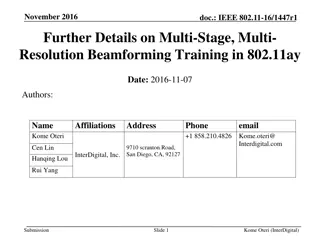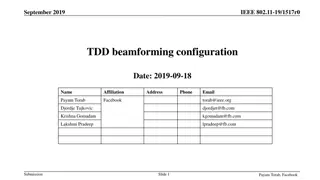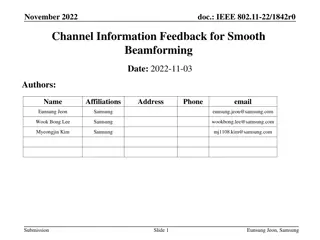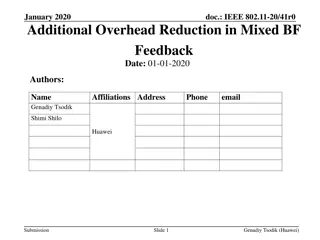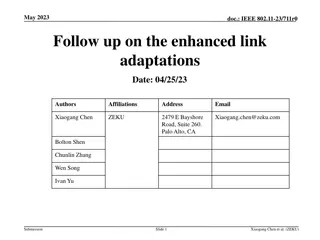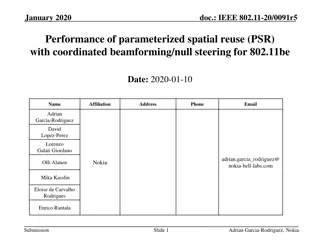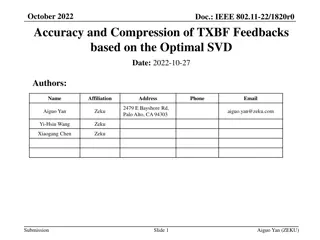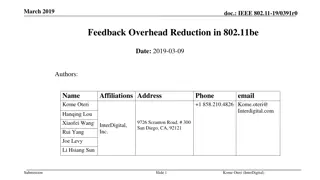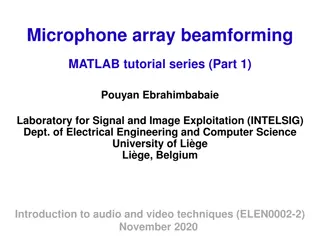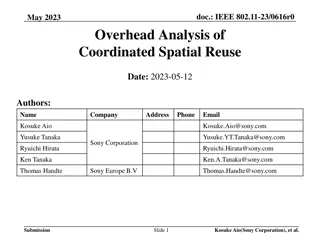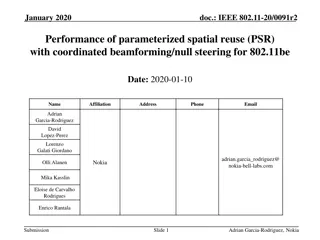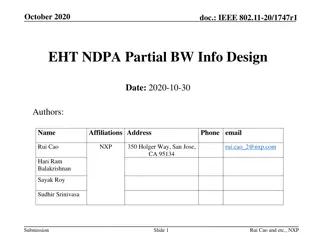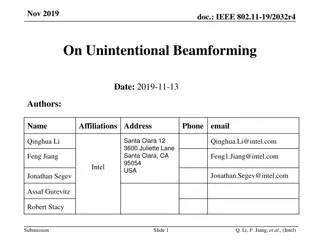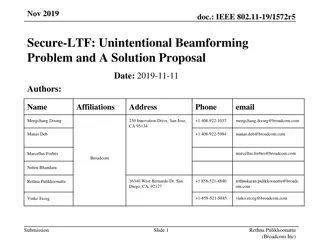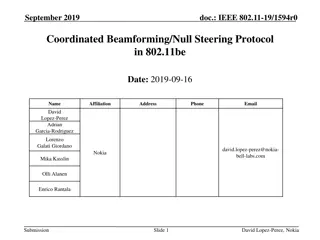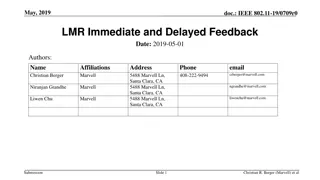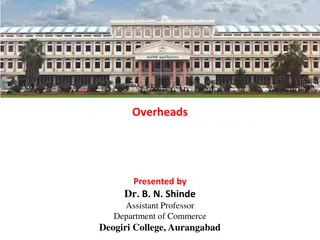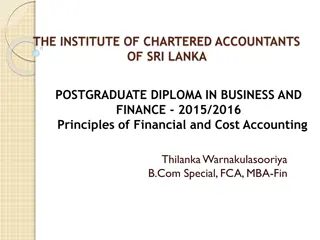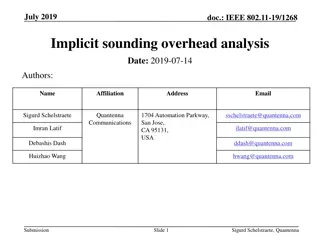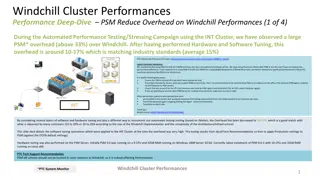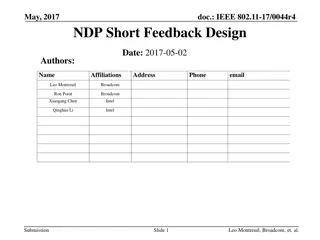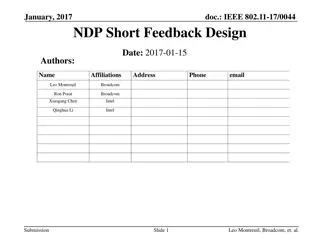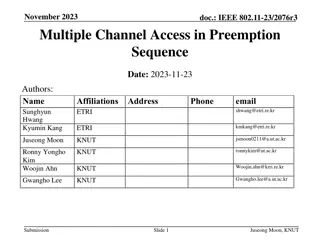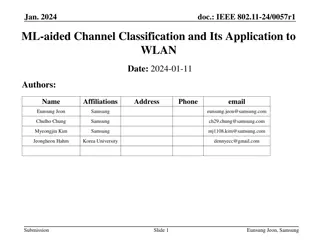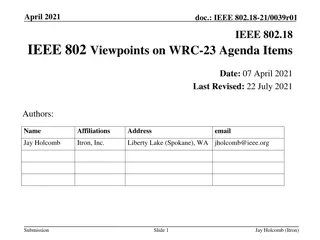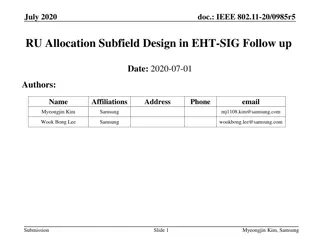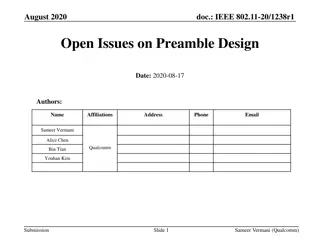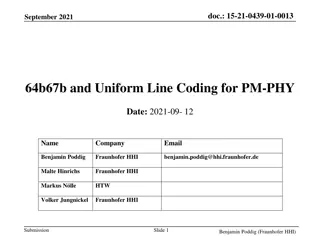Smooth Beamforming with Feedback Overhead Reduction in IEEE 802.11-23
This document discusses a method for reducing feedback overhead in smooth beamforming to optimize phase rotations for V matrix in IEEE 802.11-23 standard. It explores V matrix optimization, column-wise phase shift, and beamformer side optimization to achieve channel smoothing gain at the receiver side. The proposed approach aims at minimizing additional signaling by conducting beamforming without extra feedback, improving efficiency in channel estimation and optimization.
Download Presentation

Please find below an Image/Link to download the presentation.
The content on the website is provided AS IS for your information and personal use only. It may not be sold, licensed, or shared on other websites without obtaining consent from the author. Download presentation by click this link. If you encounter any issues during the download, it is possible that the publisher has removed the file from their server.
E N D
Presentation Transcript
July 2023 doc.: IEEE 802.11-23/1143r2 Smooth Beamforming with Feedback Overhead Reduction Date: 2023-08-28 Authors: Name Affiliation Address Phone Email Insik Jung Eunsung Park Dongguk Lim Jinyoung Chun Insun Jang Sunhee Baek Yelin Yoon Geonhwan Kim Jinsoo Choi HanGyu Cho insik0618.jung@lge.com esung.park@lge.com dongguk.lim@lge.com jiny.chun@lge.com 19, Yangjae-daero 11gil, Seocho-gu, Seoul 137- 130, Korea insun.jang@lge.com LG Electronics sunhee.baek@lge.com yl.yoon@lge.com geonhwan.kim@lge.com js.choi@lge.com hg.cho@lge.com Submission Slide 1 Insik Jung, LG Electronics
July 2023 doc.: IEEE 802.11-23/1143r2 Introduction Smooth beamforming enables obtaining smoothing gain at the receiver side when beamforming is applied [1]-[6]. Previous works [1]-[6] propose to conduct V matrix optimization to resolve the discontinuity of the estimated channel In this contribution, we propose a method to reduce additional feedback overhead to deliver the optimized phase rotations for V matrix Submission Slide 2 Insik Jung, LG Electronics
July 2023 doc.: IEEE 802.11-23/1143r2 Recap: V matrix Optimization It is shown in [4] that optimized column-wise phase shift resolves discontinuity of beam-steering matrices among adjacent tones Resolving discontinuity results in obtaining channel smoothing gainat the receiver side Discontinuty has been resolved after V matrix optimization Submission Slide 3 Insik Jung, LG Electronics
July 2023 doc.: IEEE 802.11-23/1143r2 Beamformer Side Optimization BFer BFee Channel estimation (BFee) Estimate of the channel matrix H H=U VH Feedback (BFee) Feedback of VD, where D is the diagonal matrix to make last row of V to be real values Optimization (BFer) BFer optimizes D* using VD Beamforming (BFer) BFer conducts VDD* beamforming No additional signaling NDPA NDP Estimation of H Compressed beamforming feedback D* optimization data PPDU Submission Slide 4 Insik Jung, LG Electronics
July 2023 doc.: IEEE 802.11-23/1143r2 Beamformee Side Optimization BFer BFee Channel estimation (BFee) Estimate of the channel matrix H H=U VH Optimization (BFee) STA optimizes D* using VD Feedback (BFee) Feedback of VD, where D is the diagonal matrix to make last row of V to be real values Additional feedback of D* Beamforming (BFer) AP conducts VDD* beamforming NDPA NDP -Estimation of H -D* optimization Compressed beamforming feedback data PPDU Submission Slide 5 Insik Jung, LG Electronics
July 2023 doc.: IEEE 802.11-23/1143r2 Comparison: BFer and BFee side FER of BFer-side and BFee-side optimization is almost same If BFer has optimization capability, we observed that BFer side optimization might be advantageous than BFee- side optimization in terms of throughput. Parameters Ng MCS BW MIMO configuration Values 4 7 40MHz 4 by 2 Submission Slide 6 Insik Jung, LG Electronics
July 2023 doc.: IEEE 802.11-23/1143r2 Possible Scenarios Scenario 1: BFer has an optimization capability BFer side optimization might be a better option in terms of throughput Scenario 2: BFer doesn t have an optimization capability If BFer is a non-AP STA, it may not have optimization capability because of the computation cost In this scenario, BFee may conduct optimization instead of BFer and feedback the optimization result to the BFer. For example, it might be conducted in UL SU MIMO In our contribution, we propose a overhead reduction method for Scenario 2. Submission Slide 7 Insik Jung, LG Electronics
July 2023 doc.: IEEE 802.11-23/1143r2 Part-of-tone Optimization Notice that discontinuity on euclidean distance happens intermittently. Then, we don t have to optimize every tones Proposal Just optimize for the tones from the first discontinuity We may set threshold value to detect the first discontinuity Only feedback D* for the optimized tones Benefit Reduction of feedback overhead for D* The first discontinuity based on the threshold threshold We don t have to optimize these tones First discontinuity happens in the tone index n Submission Slide 8 Insik Jung, LG Electronics
July 2023 doc.: IEEE 802.11-23/1143r2 Simulation Settings General parameters BW = 40MHz MCS = 7 Antenna configuration 4 by 2 Quantization (Phi, psi) = (6,4) bits Channel model TGnD, NLoS Receiver option LMMSE receiver LS channel estimation Submission Slide 9 Insik Jung, LG Electronics
July 2023 doc.: IEEE 802.11-23/1143r2 Simulation Results [FER] Baseline: w/o optimization Option 1: Full tone optimization Option 2: Part of tone optimization Option 2-1) Threshold = 1.2 Option 2-2) Threshold = 0.8 Option 2-3) Threshold = 0.4 Note: # of additional indication bits (e.g. optimization starting tone index) has been considered as 9 bits (which can be 12 bits for 320MHz BW) [Overhead analysis] Option 1 Option 2-1 801.6 (45.2% reduction) Option 2-2 1106.6 (24.4% reduction) Option 2-3 1357.7 (7.2% reduction) Additional bits Compare w/ baseline 1464 24% increased 13.1% increased 18.14% increased 22.3% increased Submission Insik Jung, LG Electronics Slide 10
July 2023 doc.: IEEE 802.11-23/1143r2 Conclusion In this contribution, the part of tone optimization and feedback method has been proposed. The simulation results has shown that proposed method reduces feedback overhead without significant FER loss. Submission Slide 11 Insik Jung, LG Electronics
July 2023 doc.: IEEE 802.11-23/1143r2 References [1] 11-05-1635-01-000n-wwise-preambles-and-mimo-tx-beamforming [2] 11-22-1392-00-0uhr-beamforming-improvement-for-uhr [3] 11-22-1820-01-0uhr-bf-feedback-with-the-optimal-svd [4] 11-22-1842-00-0uhr-channel-information-feedback-for-smooth- beamforming [5] 11-22-1869-01-0uhr-txbf-based-on-the-optimal-svd [6] E. Jeon, M. Ahn, S. Kim, W. B. Lee and J. Kim, "Joint Beamformer and Beamformee Design for Channel Smoothing in WLAN Systems," in Proc. IEEE 92nd Veh. Technol. Conf. (VTC2020-Fall), Nov. 2020, pp. 1- 6. Submission Slide 12 Insik Jung, LG Electronics
July 2023 doc.: IEEE 802.11-23/1143r2 Appendix 2 by 2 MIMO performance Submission Slide 13 Insik Jung, LG Electronics
July 2023 doc.: IEEE 802.11-23/1143r2 Appendix Discussions FER Effect of discontinuity is smaller than that of 4 by 2 Additional smoothing gain provided by optimization is about 1dB Overhead When threshold is 0.8, proposed scheme reduces 60.8% overhead compared to the full-tone optimization scheme Submission Slide 14 Insik Jung, LG Electronics


